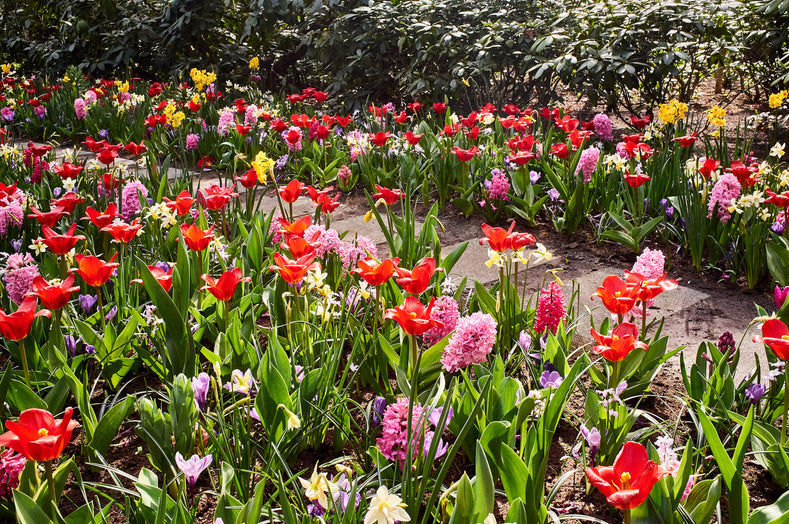There are two good reasons why you might want to plant mixtures of bulbs in your garden borders. Instead of clumps of a single variety of bulb you may want a blend of colours as part of a broader garden planting scheme. Alternatively, you may hope to have a harmonious selection of bulbs flowering in sequence throughout the season.
You might already have a plan and set about creating your own mixtures or, alternatively, be inspired by the mixtures shown in a bulb company’s catalogue. Both approaches can work in your favour.
Ordering a mixture of tulips or daffodils from a company such as Dutch Grown has the advantage that it has been created by professionals. They have walked the bulb fields and created mixtures that were flowering at the same moment and that work perfectly together.

You could do this yourself based upon experience or at least based upon carefully researched expectations. For example, Single Early group tulips, not surprisingly, flower in early spring, long before Lily flowered and Double Late group tulips. Make a mixture using only cultivars from one of these groups and they will probably flower at the same time. Of course there are variations in flowering times and the whether can often make a fool of such carefully laid plans.
Care needs to be taken in choosing a mixed collection. Some will be early flowering such as the Emperor Collection that has a gentle blend of yellow, orange and white Fosteriana Group tulips. These are my favourite early season tulips.
Mixtures Triumph group tulips that are mid-season flowering open a host of possible colour blends such as the red and purple Golden Gate collection, and the red and white Candy Cane.

Darwinhybrid tulips are bigger and bolder than Triumph tulips. In the right place a mixture such as the red, white and pink Strawberry Fields or the orange and red Sunny Days collections are guaranteed to flower on cue.
One tulip bulb mixture not to be overlooked is The Legends Collection. Tulip ‘Princess Irene’ was registered in 1949 and since then it has mutated to create a number of sports similar in stature and colour. This famous tulip is orange with a maroon outer flame and the two new sports included here are ‘Ravana’, yellow with an orange flame and ‘Pretty Princess’, pink with burgundy.
Late flowering tulips and bulbs such as Fritillaria and Allium should be important components of our garden borders. Scattered loosely between border perennials, mixtures such as red and black in the Oktoberfest collection and the sophisticated blend of apricot and black Single Late tulips in the Alabama Collection are waiting to complete the garden picture.
Another reason for creating mixtures is to be able to extend the flowering season. You might plant a mixture of early and late flowering daffodils to include a range of pale and intense yellow tones that transitions from the start to the end of spring. To do so requires careful research, however a mixture such as The Eight Weeks of Daffodils collection takes the hard work out of your hands.
Likewise, tulips in one form or another are to be found flowering over a three month period in spring. I use a lot of red tulips for maximum impact in the garden and a mixture including Single Early, Triumph, Lily flowered and Single Late group red-flowering cultivars works perfectly for me. And, perhaps this is an example of a mixture that you will not find commercially available.

One thing worth pointing out is that the catalogue photos show you how the different bulbs in a mix work together, but please don’t plant them like this in your garden borders. A pot of a mixed collection will actually look quite good, but in the garden you should really spread the bulbs out to cover a wide area in your borders. The blend of colours will still register and the effect will have a much wider impact.
This point is most clearly illustrated at the Dutch bulb garden, the Keukenhof, where bulb growers regularly plant complex mixtures of many different types of bulbs. In such schemes there will be not only many different types of tulips and daffodils, but also many other appropriate bulb species. Crown Imperials and other Fritillaria species together with crocus, hyacinths and grape hyacinths, Muscari, can often all appear together in these schemes. Again this would not be the way to use such bulbs in the garden, but such mixed displays are useful demonstrations of which varieties work well together when flowering at exactly the same time.


